Semantic Representation and Location Provenance of Cultural Heritage Information: the National Gallery Collection in London
Abstract
:1. Introduction
2. CrossCult Ontology
2.1. The CrossCult Knowledge Base
2.2. CrossCult Upper level Ontology
2.3. CrossCult venue Ontology
3. Preparing National Gallery Data
3.1. Internal Data Aggregation
- Painting inventory ID: Accession Number, unique painting ID.
- Painting date(s): relevant dates for the painting, including date of production, dates of exhibitions and modifications, etc.
- Artist(s): The name of the artist or artist involved in the production of the painting. This will also include details relating to unknown groups of related artists, such as “Workshop of …”, “Follower of …” etc.
- Group: Indicates if a given painting is part of a defined group of paintings. The paintings in these groups are normally directly physically related rather than of a similar type. For example paintings that used to be part of the same altarpiece, paintings that were all created as part of one installation, double sided paintings, etc.
- Painting title: Full title of a painting. Additional alternative titles may also be available; a shortened version of the title will also be available.
- Medium and support: Short terms used to describe the main key materials used to create a given painting, for example “Oil on Canvas”.
- Painting dimensions: The physical height and widths of a given painting in centimetres.
- Credit line: Were available, details of specific acquisitions credits, including the name and date of a given bequest. This can include details of more than one event and date.
- Public locations: The name or number of the specific Gallery in which the painting is held. All paintings that are not on display are given the generic location of “Not on display”.
- Inscription summary: Textural details describing the presence and locations of any specific marks, signatures, dates or more general inscriptions noted on a given painting.
- Classifications and keywords: General type and grouping classification terms, along with more general subject matter related keywords.
- Additional paintings details:
- Description: Short textural description of the painting and its history, drawn from the National Gallery public website content management system.
- Unique Artist ID.
- Artist name: Were possible including know variations and translations of these names.
- Artist date(s): Generally the date of birth and death on an artist, but possibly dates relating to when they were known to be alive, active or when their work was documented.
- Short artist’s biography, where available.
3.2. Extending the National Gallery Core Data—Keywords
3.3. Extending National Gallery Painting Location Data
4. Mapping NG data to the CIDOC-CRM
5. Conclusions
Author Contributions
Funding
Conflicts of Interest
References
- Hyvönen, E. Publishing and Using Cultural Heritage Linked Data on the Semantic Web; Morgan & Claypool: Palo Alto, CA, USA, 2012; pp. 1–159. [Google Scholar]
- Oldman, D.; Doerr, M.; de Jong, G.; Norton, B. Realizing lessons of the last 20 years: A manifesto for data provisioning & aggregation services for the digital humanities (a position paper). D-lib Magazine 2014, 20, 7–8. [Google Scholar] [CrossRef]
- Vlachidis, A.; Bikakis, A.; Kyriaki-Manessi, D.; Triantafyllou, I.; Padfield, J.; Kontiza, K. Semantic representation and enrichment of cultural heritage information for fostering reinterpretation and reflection on the European history. In Digital Cultural Heritage; Springer: Cham, Switzerland, 2018; pp. 91–103. [Google Scholar]
- Doerr, M. The CIDOC Conceptual Reference Module: An Ontological Approach to Semantic Interoperability of Metadata. AI Mag. 2003, 24, 75–92. [Google Scholar]
- Kurtz, D.; Parker, G.; Shotton, D.; Klyne, G.; Schroff, F.; Zisserman, A.; Wilks, Y. CLAROS—Bringing Classical Art to a Global Public. Fifth IEEE Int. Conf. e-Sci. 2009, 11, 20–27. [Google Scholar] [CrossRef]
- Oldman, D.; Tanase, D. Reshaping the Knowledge Graph by Connecting Researchers, Data and Practices in ResearchSpace. In Proceedings of the International Semantic Web Conference, Monterey, CA, USA, 8–12 October 2018. [Google Scholar]
- Gruber, E.; Bransbourg, G.; Heath, S.; Meadows, A. Linking Roman Coins: Current Work at the American Numismatic Society. In Proceedings of the 40th Conference in Computer Applications and Quantitative Methods in Archaeology, CAA2012, Southampton, UK, 26–29 March 2012. [Google Scholar]
- Meghini, C.; Niccolucci, F.; Felicetti, A.; Ronzino, P.; Nurra, F.; Papatheodorou, C.; Gavrilis, D.; Aloia, N.; Binding, C.; Cuy, S.; et al. ARIADNE: A Research Infrastructure for Archaeology. J. Comput. Cult. Herit. 2017, 10, 1–27. [Google Scholar] [CrossRef]
- Vlachidis, A.; Bikakis, A.; Kyriaki-Manessi, D.; Triantafyllou, I.; Antoniou, A. The CrossCult Knowledge Base: A Co-Inhabitant of Cultural Heritage Ontology and Vocabulary Classification. In New Trends in Databases and Information Systems. ADBIS 2017. Communications in Computer and Information Science; Kirikova, M., Ed.; Springer: Cham, Switzerland, 2017; pp. 353–362. [Google Scholar]
- Doerr, M.; Hiebel, G. Where did the Varus battle take place?—A spatial refinement for the CIDOC CRM ontology. In Proceedings of the Seventh World Archaeological Congress, The Dead Sea, Jordan, 13–18 January 2013. [Google Scholar]
- Ruthven, I.; Chowdhury, G.G. Cultural Heritage Information: Access and Management; Neal-Schuman, an imprint of the American Library Association: Chicago, IL, USA, 2015. [Google Scholar]
- Baca, M.; Gill, M. Encoding Multilingual Knowledge Systems in the Digital Age: The Getty Vocabularies. Knowl. Organ. 2015, 42, 232–243. [Google Scholar] [CrossRef]
- Kontiza, K.; Liapis, A.; Padfield, J. Capturing the Virtual Movement of Paintings: A Game and A Tool. In Proceedings of the Digital Heritage Conference New Realities: Authenticity & Automation in the Digital Age, 3rd International Congress, San Francisco, CA, USA, 26–30 October 2018. [Google Scholar]
- Keith, L. Colour change and restoration. In Colour Change in Paintings; Gent, A., Rhiannon, C., Dowding, H., Eds.; Archetype Publications Ltd.: London, UK, 2016. [Google Scholar]
| 1 | https://www.crosscult.eu/ Accessed January 29, 2019. |
| 2 | https://www.researchspace.org/ Accessed January 29, 2019. |
| 3 | http://www.cidoc-crm.org/ Accessed January 29, 2019. |
| 4 | http://www.southampton.ac.uk/~km2/projs/artiste/ Accessed January 29, 2019. |
| 5 | http://www.sculpteur.ecs.soton.ac.uk Accessed January 29, 2019. |
| 6 | Raphael Research Resource - http://cima.ng-london.org.uk/documentation Accessed January 29, 2019. |
| 7 | Horizon 2020 EU Research and Innovation programme - https://ec.europa.eu/programmes/horizon2020/en/ Accessed January 29, 2019. |
| 8 | Integrated Platform for the European Research Infrastructure ON Cultural Heritage - http://www.iperionch.eu/ Accessed January 29, 2019. |
| 9 | https://www.w3.org/2004/02/skos/ Accessed January 29, 2019. |
| 10 | http://xmlns.com/foaf/spec/ Accessed January 29, 2019. |
| 11 | The Art & Architecture Thesaurus: a structured vocabulary of approximately 44,000 concepts of art, architecture and culture items http://www.getty.edu/research/tools/vocabularies/aat/ Accessed January 29, 2019. |
| 12 | EuroVoc: a multilingual, multidisciplinary thesaurus, aiming to support the information management and dissemination services of the EU and its members http://eurovoc.europa.eu Accessed January 29, 2019. |
| 13 | Library of Congress Subject Authority Records http://id.loc.gov/authorities/subjects.html Accessed January 29, 2019. |
| 14 | http://www.vocabularyserver.com / Accessed January 29, 2019. |
| 15 | https://www.w3.org/TR/owl2-syntax/ Accessed January 29, 2019. |
| 16 | http://erlangen-crm.org/ Accessed January 29, 2019. |
| 17 | http://dublincore.org Accessed January 29, 2019. |
| 18 | DBpedia: a crowd-sourced generic dataset containing information created in various Wikimedia projects structured in RDF http://wiki.dbpedia.org Accessed January 29, 2019. |
| 19 | |
| 20 | http://www.cidoc-crm.org/crmba/sites/default/files/2016-12-3%23CRMba_v1.4.1_UR.pdf Accessed January 29, 2019. |
| 21 | International Image Interoperability Framework - https://iiif.io/ Accessed January 29, 2019. |
| 22 | http://iipimage.sourceforge.net/documentation/server/ Accessed January 29, 2019. |
| 23 | https://www.json.org/ Accessed January 29, 2019. |
| 24 | https://data.ng-london.org.uk/resource/examples Accessed January 29, 2019. |
| 25 | http://www.getty.edu/research/tools/vocabularies/ Accessed January 29, 2019. |
| 26 | https://www.nationalgalleryimages.co.uk/ Accessed January 29, 2019. |
| 27 | XML stands for eXtensible Markup Language and is a software- and hardware-independent tool for storing and transporting data. |
| 28 | http://php.net/ Accessed January 29, 2019 |
| 29 | https://data.ng-london.org.uk/resource/examples/rdf Accessed January 29, 2019. |
| 30 | https://media.ng-london.org.uk/iiif/examples/009-01S9-0000 Accessed January 29, 2019. |
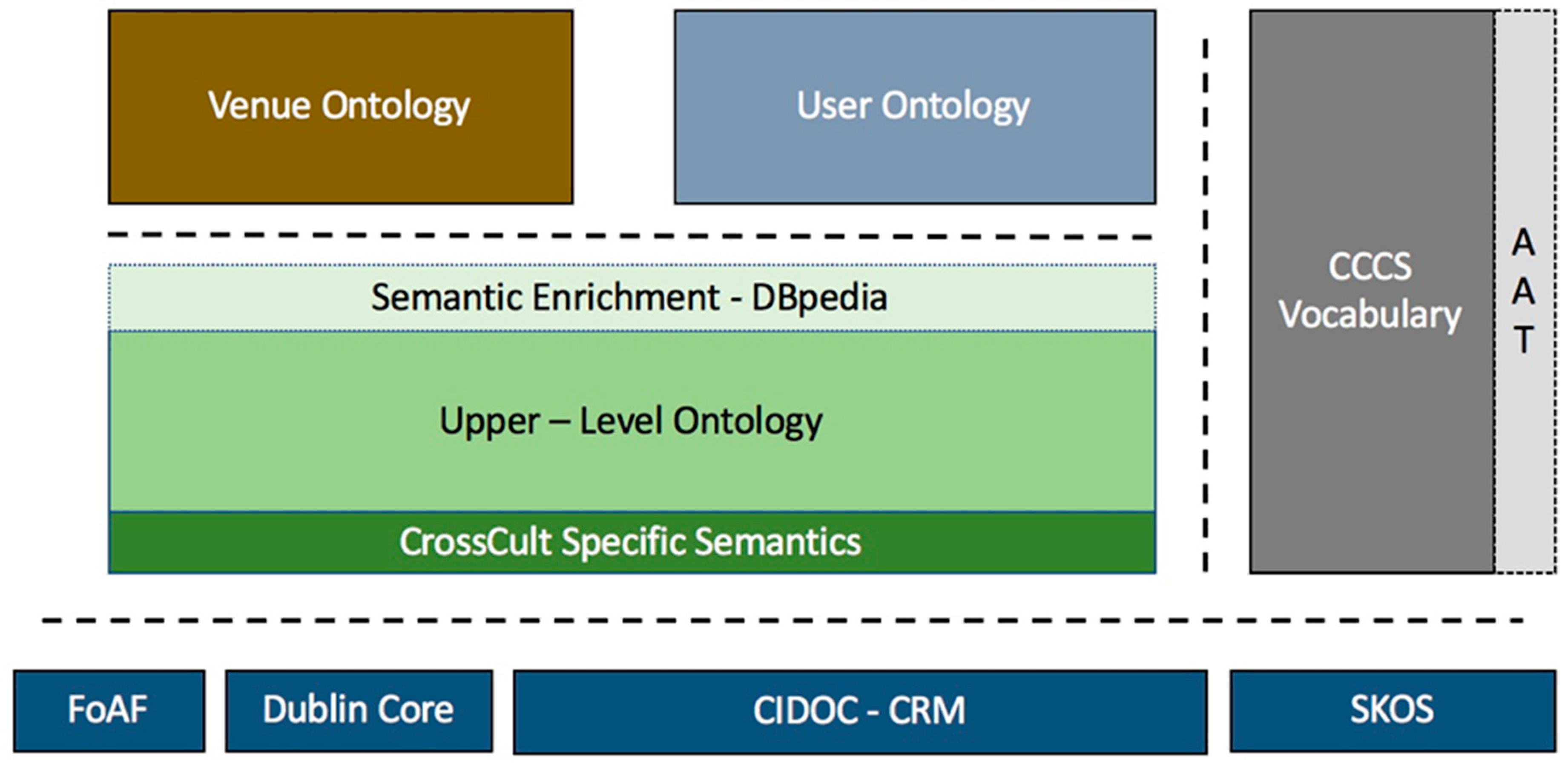
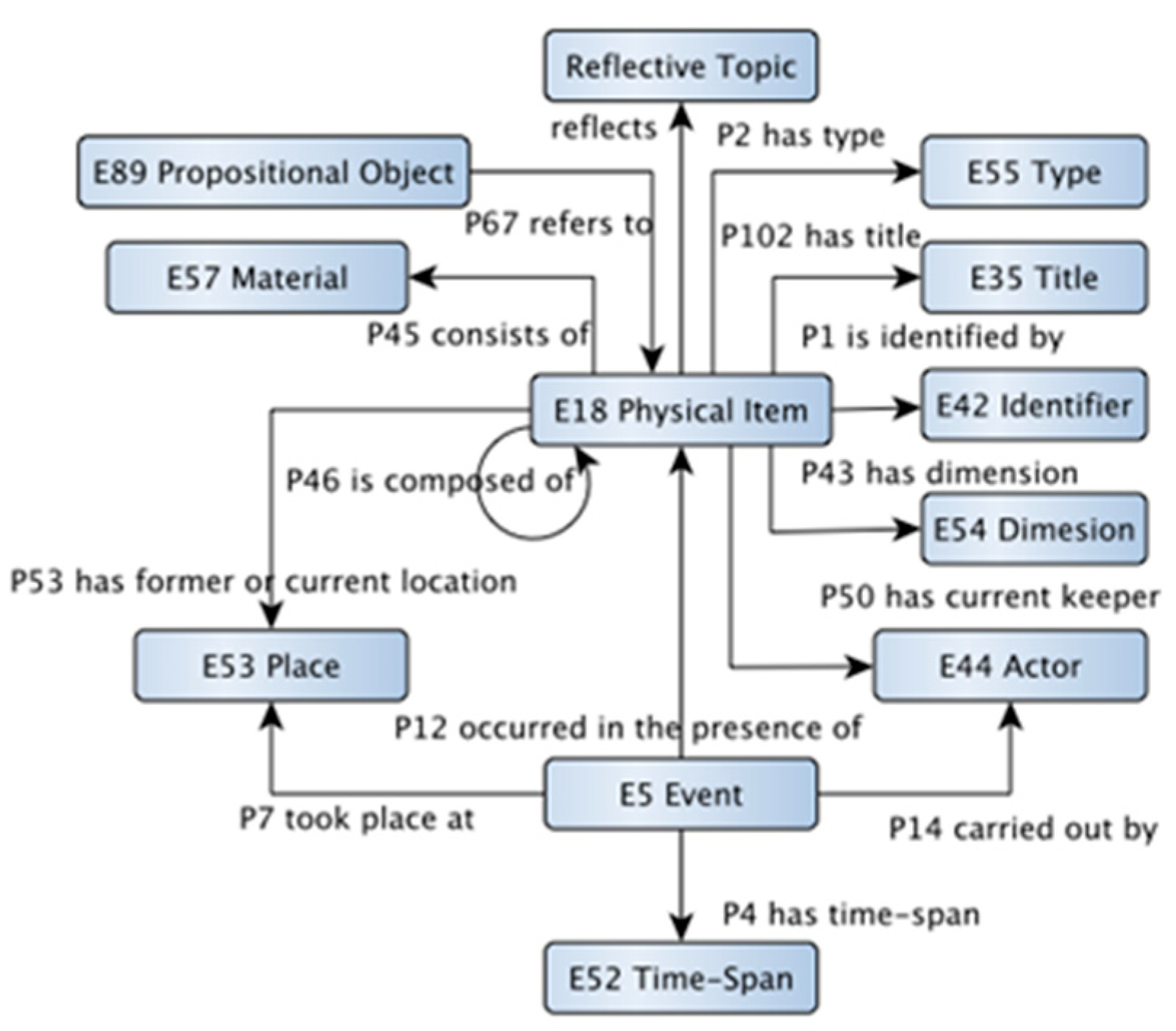
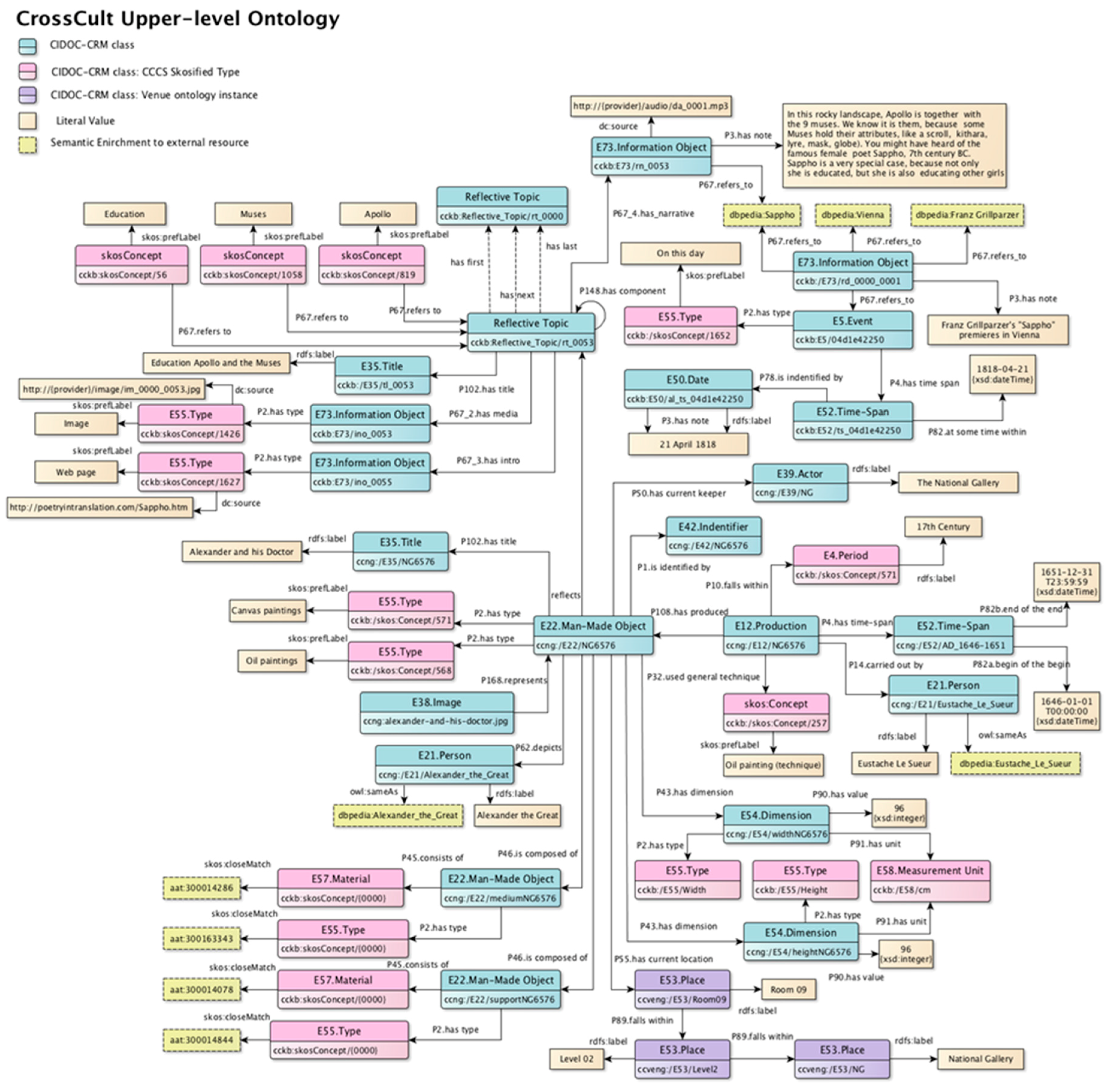

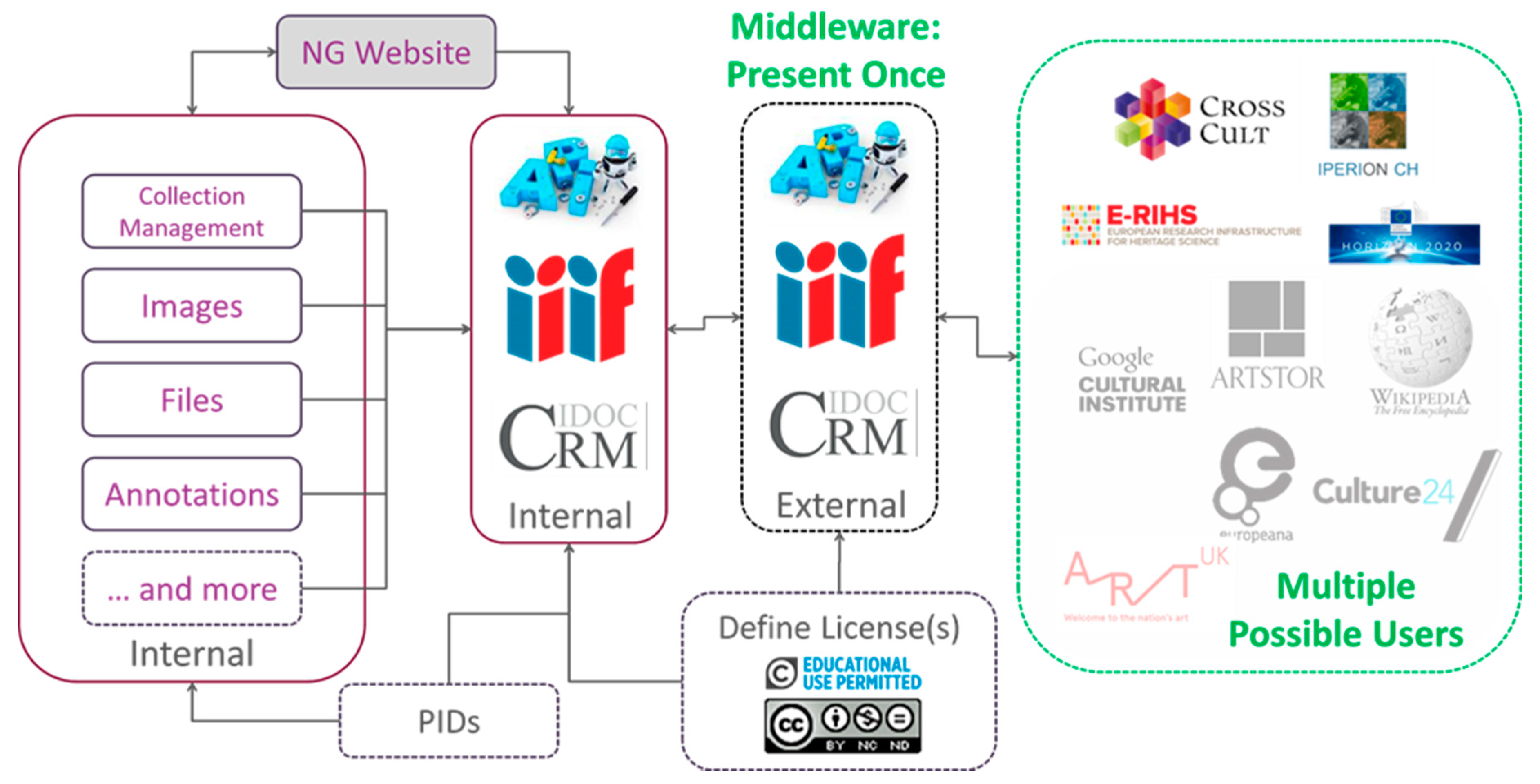
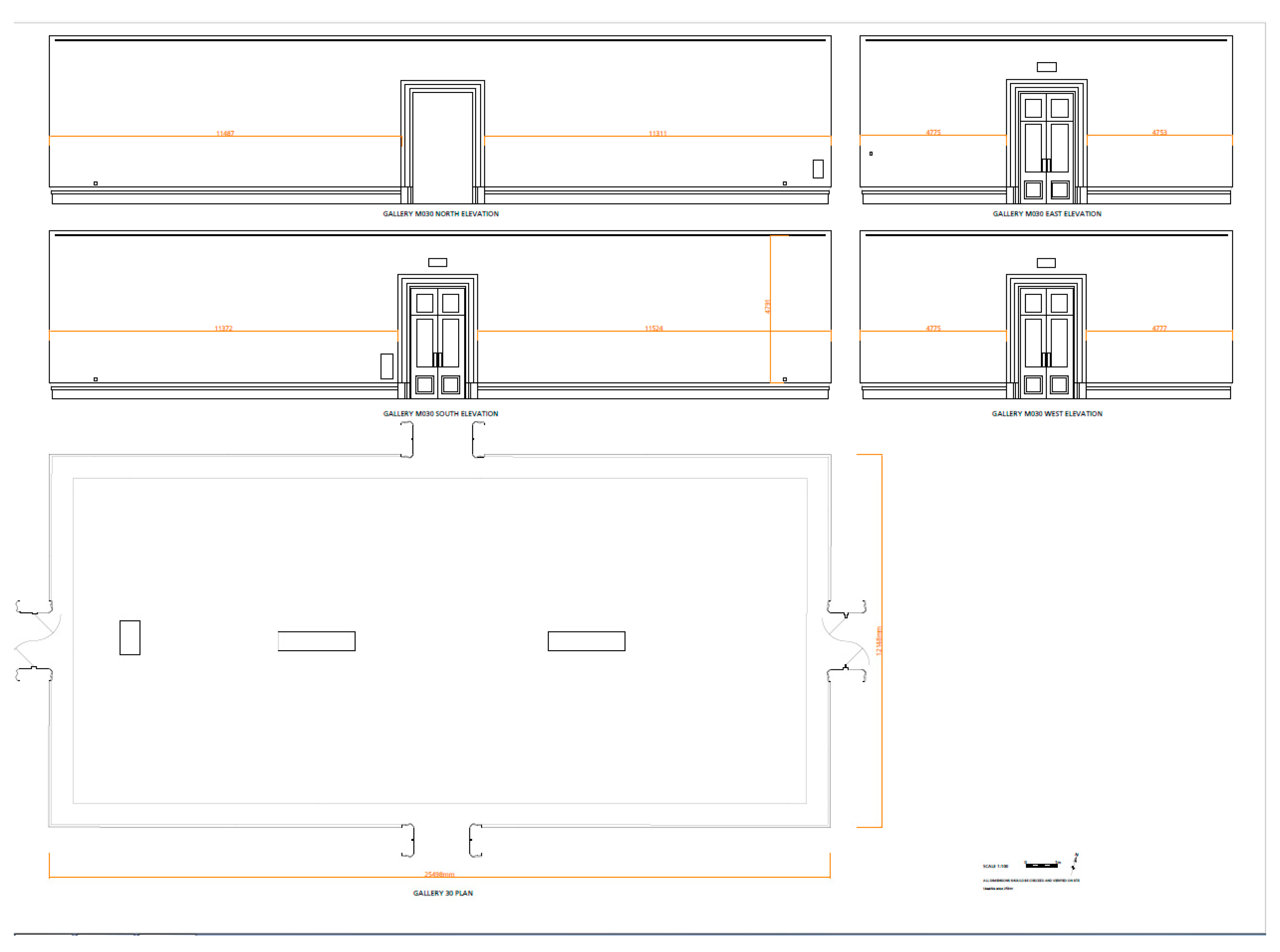
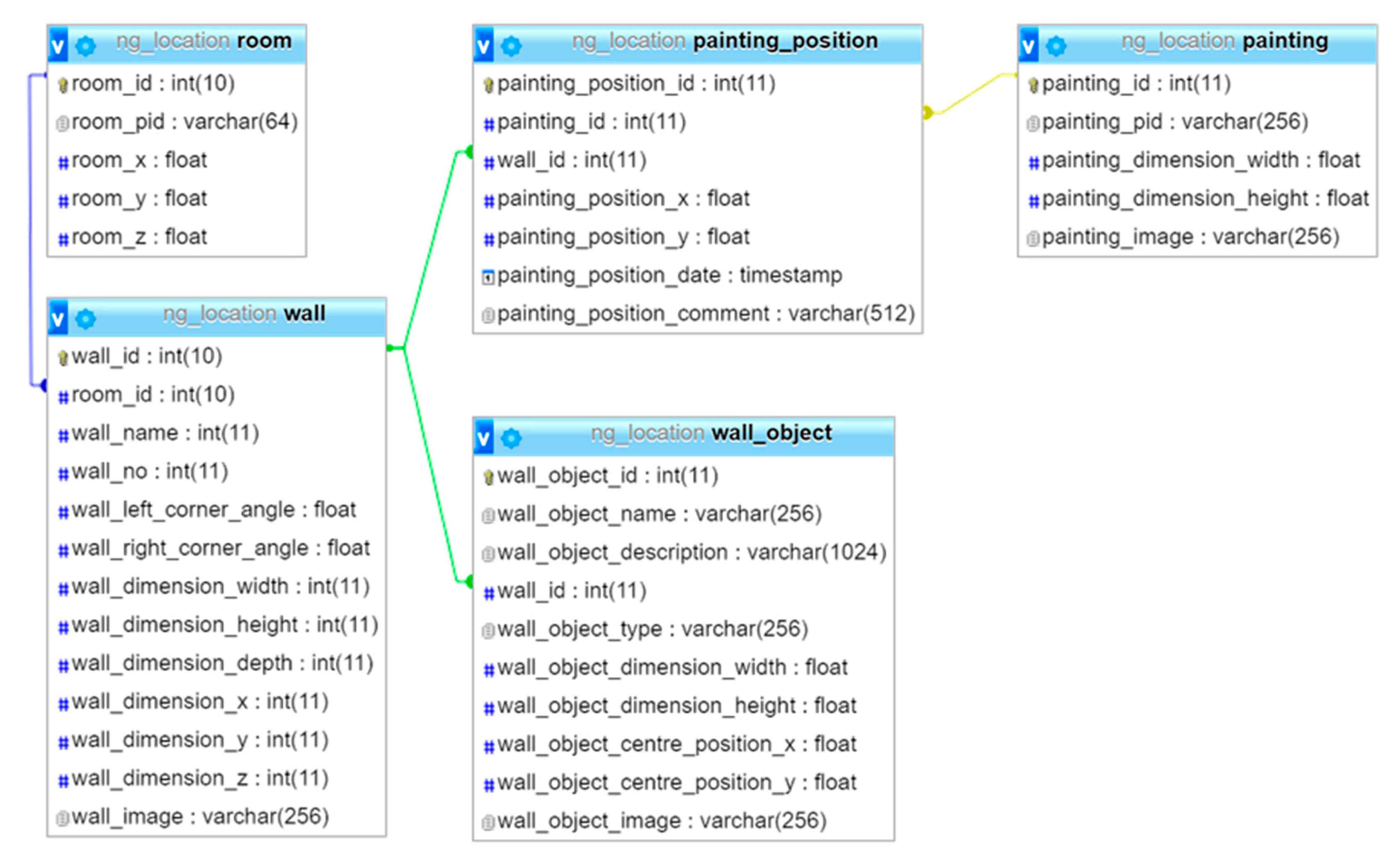
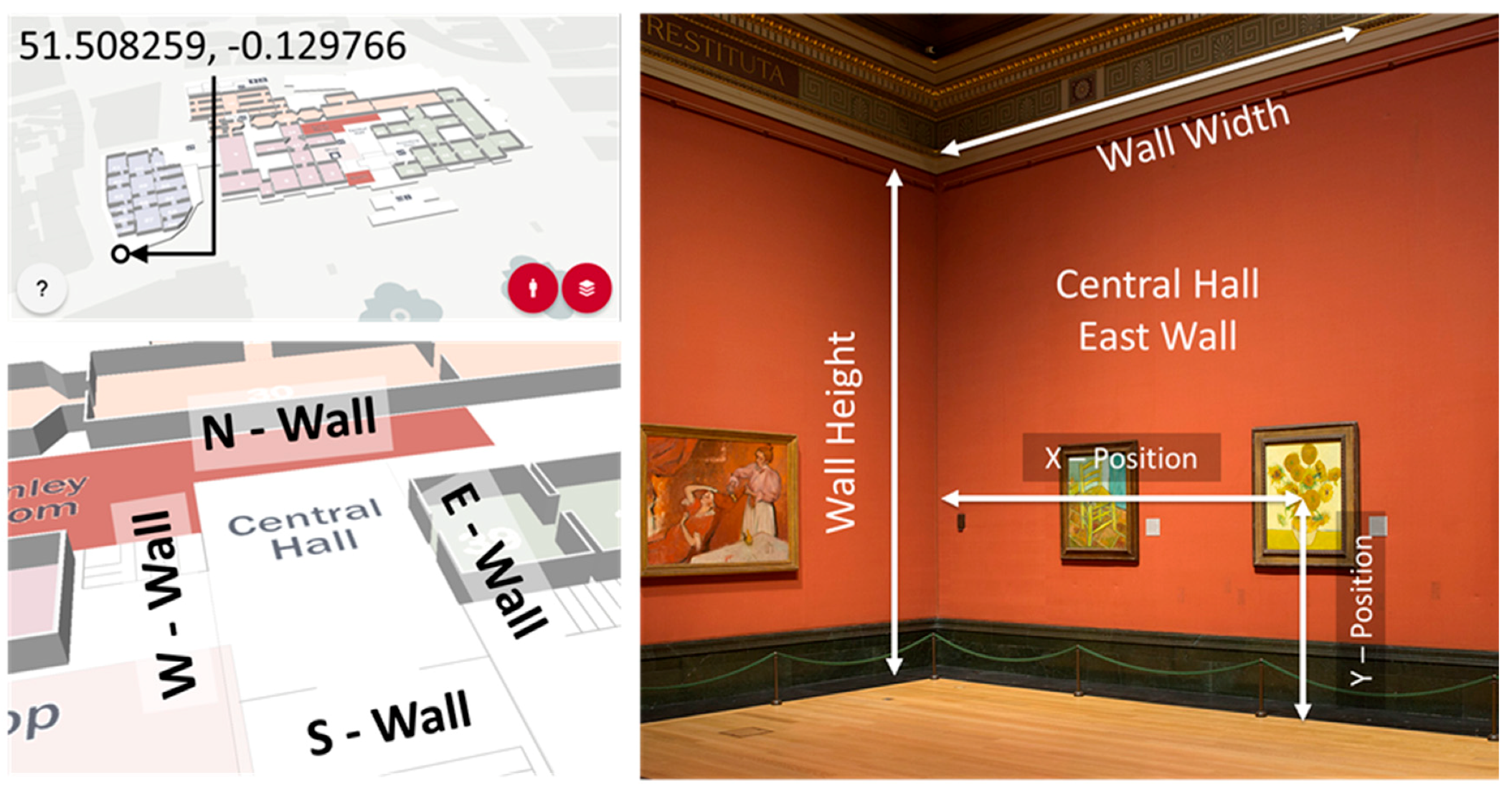
| {"type":"location","pid":"006-001M-0000","name":"Room 30","title":"Spain","description":"<p>Spanish painting flourished during the 17th century principally in the service of God and King. ...","objects":{"000-00A8-0000":{"pid":"000-00A8-0000","no":"NG6566"}, ... , ,"example_object":"000-00A8-0000","artists":{"001-01WB-0000":"Italian, Neapolitan","001-03FC-0000":"Jusepe de Ribera", ...},"date_range":{"begin":"1618-01-01","end":"1684-12-31"},"contains":[],"keywords":{"00A-0001-0000":"Religion","00A-0002-0000":"Christianity", ...},"license":"https:\/\/creativecommons.org\/licenses\/by-nc-nd\/4.0\/","attribution":"This data is licensed ... "} |
| JSON | Triples | ||
|---|---|---|---|
| {"type":"location","pid":"006-001M-0000","name":"Room 30"} | 006-001M-0000 | rdf:type crm:P102.has title | crm:E53.Place _:006-001M-0000title |
| _:006-001M-0000 | rdf:type rdf:label | crm:E35.Title Room 30@en | |
| Subject | Predicate | Object | |||
|---|---|---|---|---|---|
| ng:006-001M-0000 | rdfs:comment | Spanish painting flourished during the 17th century principally in the service of God and King. The evolution of a Catholic Counter-Reformation religiosity is revealed in a variety of powerful, individual styles. Not long after El Greco had portrayed the divine with ethereal idealisations of figures, space and light, Diego Velázquez and Francisco de Zurbarán turned to realism to represent the mystical. ….@en | |||
| Subject | Predicate | Object | Subject | Predicate | Object |
| ng:006-001M-0000 | cc:licence | https://creativecommons.org/licenses/by-nc-nd/4.0/ | ng:006-001M-0000 | crm:P102. has title | _:006-001M-0000title |
| ng:006-001M-0000 | rdf:type | crm:E53.Place | _:006-001M-0000 | rdf:type | crm:E35.Title |
| ng:006-001M-0000 | rdf:label | Room 30@en | _:006-001M-0000 | rdf:label | Room 30@en |
| ng:006-001M-0000 | P89.falls within | ng:006-0033-0000 | ng:006-001M-0000 | crm:P102. has title | _:006-001M-0000subtitle |
| ng:006-001M-0000 | P89.falls within | ng:006-003S-0000 | _:006-001M-0000subtitle | rdf:type | crm:E35.Title |
| ng:000-00A8-0000 | crm:P55.has current location | ng:006-001M-0000 | _:006-001M-0000subtitle | rdf:label | Spain@en |
| ng:000-0196-0000 | crm:P55.has current location | ng:006-001M-0000 | _:006-001M-0000subtitle | crm:P2. has type | ng:00A-00DU-0000 |
| _:006-001M-0000 | crm:P2.has type | ng:00A-00DP-0000 | ng:00A-0002-0000 | crm:P67. refers to | ng:006-001M-0000 |
| Subject | Predicate | Object | |||
|---|---|---|---|---|---|
| ng:000-01D6-0000 | rdfs:com- ment | This is the only surviving example of a female nude by Velázquez. The subject was rare in Spain because it met with the disapproval of the Church.Venus, the goddess of Love, was the most beautiful of the goddesses, and was regarded as a personification of female beauty […] The painting is known as ’The Rokeby Venus’ because it was in the Morritt Collection at Rokeby Park, now in County Durham, before its acquisition by the Gallery. @en | |||
| Subject | Predicate | Object | Subject | Predicate | Object |
| ng:000-01D6-0000 | cc:licence | https://creativecommons.org/licenses/by-nc-nd/4.0/ | ng:000-01D6-0000 | crm:P50. has current keeper | ng:001-02VZ-0000 |
| ng:000-01D6-0000 | rdf:type | crm:E22.Man-Made Object | ng:001-02VZ-0000 | rdf:type | crm:E39.Actor |
| ng:000-01D6-0000 | rdf:label | The Toilet of Venus (‘The Rokeby Venus’)@en | ng:001-02VZ-0000 | rdf:label | The National Gallery (London)@en |
| ng:000-01D6-0000 | crm:P48. has preferred identifier | _:000-01D6-0000 | ng:001-02VZ-0000 | crm:P2. has type | ng:00A-00DO-0000 |
| _:000-01D6-0000 | rdf:type | crm:E42.Identifier | ng:000-01D6-0000 | crm:P55. has current location | ng:006-001M-0000 |
| _:000-01D6-0000 | rdf:label | NG2057@en | ng:000-01D6-0000 | crm:P102. has title | ng:00C-01C7-0000 |
| _:000-01D6-0000 | crm:P2. has type | ng:00A-00DL-0000 | ng:00C-01C7-0000 | rdf:type | crm:E35.Title |
| ng:000-01D6-0000 | crm:P43. has dimension | _:000-01D6-0000width | ng:00C-01C7-0000 | rdf:label | The Toilet of Venus (‘The Rokeby Venus’)@en |
| _:000-01D6-0000width | rdf:type | crm:E54.Dimension | ng:00C-01C7-0000 | crm:P2.has type | ng:00A-00DQ-0000 |
| _:000-01D6-0000width | crm:P90. has value | 177.000 # xsd:decimal | ng:009-01S9-0000 | crm:P138. represents | ng:000-01D6-0000 |
| _:000-01D6-0000width | crm:P91. has unit | ng:00A-00DK-0000 | ng:002-01D6-0000 | crm:P108. has produced | ng:000-01D6-0000 |
| _:000-01D6-0000width | crm:P2.has type | ng:00A-00DM-0000 | ng:002-01D6-0000 | rdf:type | crm:E12.Production |
| ng:000-01D6-0000 | crm:P43. has dimension | _:000-01D6-0000height | ng:002-01D6-0000 | crm:P81.ongoing throughout | _:productionTimeSpan000-01D6-0000 |
| _:000-01D6-0000 height | rdf:type | crm:E54.Dimension | ng:002-01D6-0000 | rdf:type | crm:E12.Production |
| _:000-01D6-0000 height | crm:P90. has value | 122.500 # xsd:decimal | _:productionTimeSpan000-01D6-0000 | rdf:type | crm:E61.Time Primitive |
| _:000-01D6-0000 height | crm:P91. has unit | ng:00A-00DK-0000 | _:productionTimeSpan000-01D6-0000 | rdf:label | 1647-51@en |
| _:000-01D6-0000 height | crm:P2.has type | ng:00A-00DN-0000 | ng:00A-0002-0000 | crm:P67. refers to | ng:000-01D6-0000 |
| ng:00A-0003-0000 | crm:P67. refers to | ng:000-01D6-0000 | ng:00A-000H-0000 | crm:P67. refers to | ng:000-01D6-0000 |
| ng:000-01D6-0000 | crm:P46.is_composed_of | _:000-01D6-0000medium0 | ng:000-01D6-0000 | crm:P46.is_composed_of | _:000-01D6-0000support0 |
| _::000-01D6-0000medium0 | rdf:type | crm:E57.Material | _:000-01D6-0000support0 | rdf:type | crm:E57.Material |
| _:000-01D6-0000medium0 | rdfs:label | NG2057 Medium@en | _:000-01D6-0000support0 | rdfs:label | NG2057 Support@en |
| _:000-01D6-0000medium0 | crm:P2.has_type | ng:00A-00DI-0000 | _:000-01D6-0000support0 | crm:P2.has_type | ng:00A-00DJ-0000 |
| _:000-01D6-0000medium0 | crm:P45.consists_of | ng:00A-00B6-0000 | _:000-01D6-0000support0 | crm:P45.consists_of | ng:00A-00BU-0000 |
© 2019 by the authors. Licensee MDPI, Basel, Switzerland. This article is an open access article distributed under the terms and conditions of the Creative Commons Attribution (CC BY) license (http://creativecommons.org/licenses/by/4.0/).
Share and Cite
Padfield, J.; Kontiza, K.; Bikakis, A.; Vlachidis, A. Semantic Representation and Location Provenance of Cultural Heritage Information: the National Gallery Collection in London. Heritage 2019, 2, 648-665. https://doi.org/10.3390/heritage2010042
Padfield J, Kontiza K, Bikakis A, Vlachidis A. Semantic Representation and Location Provenance of Cultural Heritage Information: the National Gallery Collection in London. Heritage. 2019; 2(1):648-665. https://doi.org/10.3390/heritage2010042
Chicago/Turabian StylePadfield, Joseph, Kalliopi Kontiza, Antonis Bikakis, and Andreas Vlachidis. 2019. "Semantic Representation and Location Provenance of Cultural Heritage Information: the National Gallery Collection in London" Heritage 2, no. 1: 648-665. https://doi.org/10.3390/heritage2010042
APA StylePadfield, J., Kontiza, K., Bikakis, A., & Vlachidis, A. (2019). Semantic Representation and Location Provenance of Cultural Heritage Information: the National Gallery Collection in London. Heritage, 2(1), 648-665. https://doi.org/10.3390/heritage2010042






